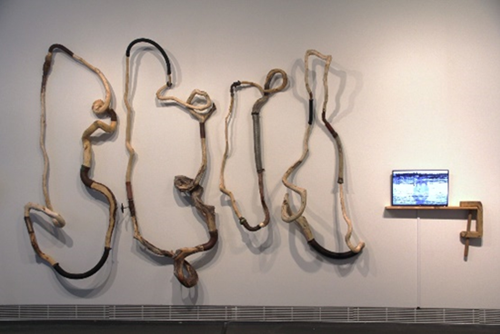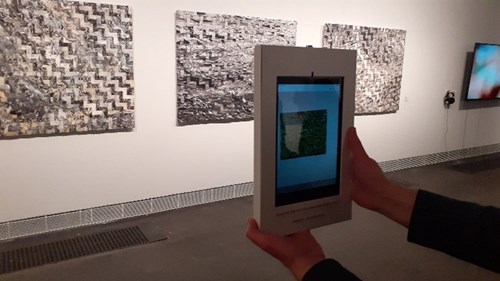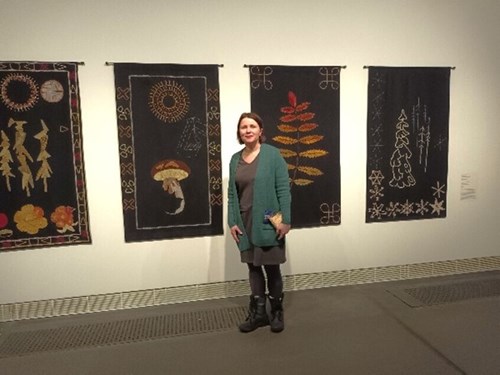The exhibition "Shifting Ground – Muuttuva maa" at the Rovaniemi Art Museum is a result of a five-year interdisciplinary and experimental art and research project called "Shifting Ground: Mapping Energy, Geography and Communities in the North", funded by the Social Science and Humanities Research Council of Canada (SSHRC). Professor Ruth Beer from Emily Carr Art and Design University in Vancouver served as the project's lead and principal investigator (PI), while Professor, Chair of UArctic Art, Design and Culture Timo Jokela from the University of Lapland was responsible for the project as co-researcher (Go-PI). The project explores the changes and communities in the Arctic region, aiming to stimulate new thinking and action around resource utilization, climate change, and socio-environmental adaptation.
"The project was designed to stimulate new thinking and action around resource utilization, climate change, and socio-environmental adaptation. By exploring these themes through the lens of contemporary art, the project aims to connect local resilience with global concerns. The theme and activities are closely intertwined with the collaboration of the Arctic University's Arctic Sustainable Arts and Design (ASAD) network, which I coordinate. However, it has also provided me with a valuable opportunity to examine in my art the congruent changes in Canada, the Yukon region, and my own homeland along the Ounasjoki River in Finland, Lapland", Jokela explains.
The exhibition, which opened on February 1, 2024, at the Rovaniemi Art Museum, features artists from the Shifting Ground project, including Timo Jokela, Ruth Beer, Maureen Gruben, Tsema Igharas, Lindsay McIntyre, and Jeneen Frei Njootli from Canada.

Timo Jokela. At the River – Stepping in the Flow. Installation and video; 2024. Photo: Timo Jokela. The artwork addresses the impacts of gold mining on the Yukon River in Canada and the Ounas River in Finland.
The exhibition was realized in collaboration with the Artists' Association of Lapland, which organized an open call for its members. Among the artists-researcher selected from the University of Lapland are Lola Cervant, Maria Huhmarniemi, Mari Mäkiranta, Marjo Pernu, Simi Ruotsalainen & Johanna Ruotsalainen, Antti Stöckell, and Seija Ulkuniemi. Their works include photography, video, textiles, and installations. Additionally, Tommi Yläjoki and Maria Huhmarniemi presented a performance at the opening addressing mining projects in the era of overconsumption.
The exhibition's curators are Ruth Beer from the Emily Carr University and Ulla Viitanen from the the Rovaniemi Art Museum. They describe the exhibition as a path created through art to perceive, present, and explore shared experiences and emotions at the center of climate change and increasing extreme conditions.

Ruth Beer’s three artworks consist of overlappingly woven shreds of photos of water and oil. They can be viewed on an iPad, where augmented reality brings forth a message of hope within the images. Photo. Timo Jokela
"The artworks make visible the stories etched into the surface and deep beneath the earth. The pieces highlight phenomena related to climate change in northern regions, the utilization of natural resources, changing environments, and future challenges", as explained by the curators.
The exhibition is supported by the Embassy of Canada, the Social Sciences and Humanities Research Council of Canada, the Finnish Heritage Agency through funding to the Rovaniemi Art Museum, and the Kone Foundation through funding to the Artists' Association of Lapland.
All the participating artists in the exhibition are Ruth Beer, Lola Cervant, Maureen Gruben, Maria Huhmarniemi, Tsema Igharas, Timo Jokela, Eemil Karila, Miia Kettunen, Elina Länsman, Lindsay McIntyre, Mari Mäkiranta, Jeneen Frei Njootli, Marjo Pernu, Marjo Pitko, Simi Ruotsalainen & Johanna Ruotsalainen, Antti Stöckell, and Seija Ulkuniemi.

Maria Huhmarniemi in front of her artworks series Hannukainen mining plan, 2023. Photo: Mirja Hiltunen, 2024. The work comments on the iron ore mine plan for the village of Hannukainen, in the landscape of the national park: to the lands of the midnight sun, candle spruces, cloudberries, and mushrooms. Symbols of protection and danger frame pictorial themes, as traditionally seen in blanket embroideries. Some of the embroidery patterns are only sketched with basting thread, hinting that the mining project may not come to fruition.
More information:
Timo Jokela, timo.jokela@ulapland.fi
